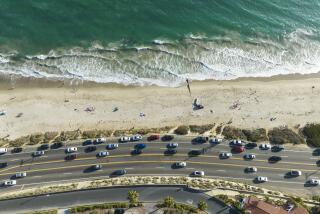Study: Sewage Stays Offshore
- Share via
The sewage that a local sanitation district pumps four miles out to sea does not appear to be flowing back to the Huntington Beach shoreline, according to preliminary study results released Wednesday.
The early findings are part of a $5.1-million Orange County Sanitation District study to determine if the 243 million gallons of waste water it pumps into the ocean every day are pushed back and foul Huntington’s shoreline. The preliminary findings show that the plume of sewage comes within a mile of the beach.
“The plume comes in toward shore,” said George Robertson, the district’s chief scientist. “But we haven’t seen it come to the beach.”
Some environmentalists contend, however, that the study is self-serving because the Sanitation District stands to lose hundreds of millions of dollars if it is proved to be the cause of beach pollution.
“I’m expecting them to come up with a clean bill of health,” local environmentalist Doug Korthof said.
After health warnings forced closures of Huntington Beach shoreline for much of the summer of 1999, scientists and county health and state water officials have been trying to find the source of the problem. Bacteria levels continued to spike at Huntington State Beach in 2000 and again this summer, causing additional warnings but no closures.
In November, UC Irvine scientist Stanley Grant theorized that a combination of forces--underwater waves and tides and the ocean water-fed cooling system of the AES Corp. power plant in Huntington Beach--are drawing the sewage back toward shore.
Grant said his theory has not been disproved by the preliminary results. “One link in the chain seems to be satisfied,” he said. “The other link, perhaps involving the AES power plant, has not been established.”
The plant has been shut down for retooling, so it wasn’t running its cooling system--which uses 300 million gallons of ocean water daily--during the four water-quality tests conducted this summer. The plant will be running during the remaining two 48-hour surveys, the first of which will begin Sunday.
In earlier surveys this summer, the sewage plume was detected around the one-mile monitoring stations only during a high flood tide, while hot spots of bacteria at the beach were seen during ebb tides.
Korthof, a longtime critic of the Sanitation District, said he was not surprised by the study’s preliminary results. “There are two flaws in the study. [UCI researcher Grant] is not involved in the experiment, design or analysis, and he’s the one who came up with the theory. Second, they’re not testing his theory because the AES plant is not running.”
District officials emphasized that the findings were tentative because much of the data--including that from 11 moorings that will measure the current every five minutes through October--are not in yet. “What we’re talking about today is preliminary data,” district spokeswoman Lisa Murphy said.
Additional studies, totaling $2 million, are examining possible inland sources, the Santa Ana River and other issues. Final results are not expected until spring 2002. Huntington Beach has also announced plans to use $4 million from Proposition 13, a $2-billion water bond measure passed by voters last year, to fight urban runoff pollution.
These preliminary findings come as controversy grows over the Sanitation District’s federal permit to discharge dirtier sewage than the Clean Water Act allows. The district, which serves 2.4 million people in northern and central Orange County, is the largest of 36 agencies nationwide that has been granted a waiver.
The waiver exempts the agency from using a more rigorous and costly treatment process that would eliminate more contaminants.
Though many pollutants are removed, the effluent contains higher concentrations of bacteria, human waste and other organic matter than sewage being discharged by nearly all of the nation’s 16,000 other public sanitation agencies. A local battle is brewing over the exemption, up for renewal late next year; several Orange County coastal cities are expected to lobby strenuously against it.
Activists have launched a city-by-city campaign to testify at city council meetings about the waiver.
Monday, they spoke in Seal Beach. The City Council will probably pass a resolution in 45 days opposing the waiver, said Councilman Shawn Boyd, a member of the Sanitation District’s board of directors.
The district is fighting back. Scott Baugh, who represented Huntington Beach in the state Assembly, has been hired to talk to community leaders about a number of issues facing the Sanitation District, including the waiver renewal.
If the district is not given a waiver extension, it would be forced to make operational changes, including building a new sewage treatment facility that could cost as much as $400 million. Such a move would also worsen air pollution and create more sewage sludge, Murphy said.
More to Read
Sign up for Essential California
The most important California stories and recommendations in your inbox every morning.
You may occasionally receive promotional content from the Los Angeles Times.











